Buying - Storing Grains, Corn & Beans
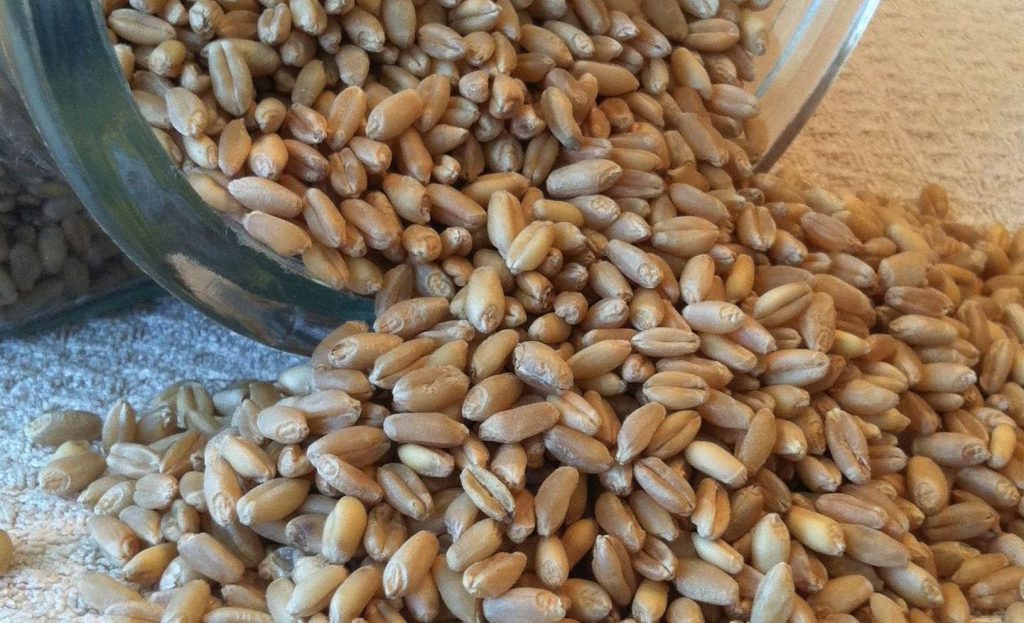
Now that you have your Grain Mill,
you will need to Buy and Store some
Whole Grain, Corn or Beans
Buying – Storing Whole Grains, Corn & Beans
Now that you have your grain mill, you will need some whole grain, corn and beans. Here we will cover buying and the proper way to store them. There is a plethora of grains from which to choose: wheat and rye, ancient grains such as Kamute and emmer; gluten-free: brown rice and millet; some grains that are really seeds: buckwheat and quinoa, just to name a few. Then of course there are corn and beans. Not saying beans are a grain, but they can certainly be ground into flour in your home mill.
Whole grains are sometimes referred to: berries, kernels or seeds. When purchasing, try to opt for organic when possible; most corn in the US for instance is now mostly GM (genetically modified). Too scary if you ask me. Dried whole grains, corn and beans will last for quite sometime, even years, if properly prepared and stored. This page will give you the info you need for buying and storing whole grains, corn and beans correctly.
Buying Grains & Beans
There are several options available depending on your location:
- Food Co-ops – The most cost effective place to purchase whole grains, corn & beans is to buy in bulk, usually through a food co-op. Buying in bulk avails one to discounted pricing and shipping/freight is much more affordable. I buy from Azure Standard; our delivery is located in Long Beach/Gulfport, Mississippi. See if they have a drop near you.
- Azure Standard Co-Op – A co-op is a group which orders typically once a month, the order is then shipped by semi-truck to a drop location on a designated day. When the truck arrives everyone helps unload the items and you take your products home. Azure Standard is kind of like a whole foods/organic store and Tractor Supply rolled into one. Simply set up an account, place items in your cart, enter the drop location number which applies to your area, then checkout. Easy peasy! Azure ships all over the country.
- Local Health Food or Whole Food Stores – Many local health food stores stock whole grains/beans and other baking supplies. If yours does not, then ask if they can order for you.
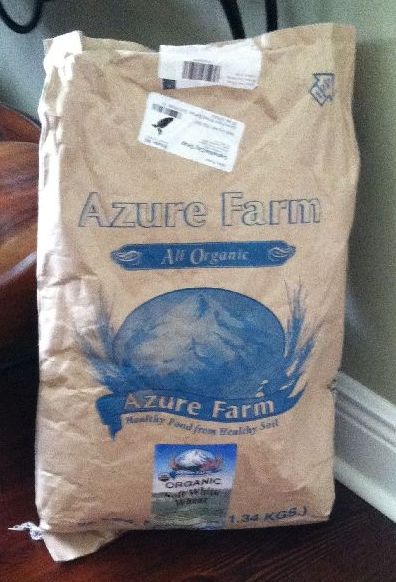
- Online/Mail Order – There is a fair number of sites/stores which offer whole grains & beans such as Amazon. Depending on the site/store the shipping cost can be as much as the bag of grain itself. So do some price comparing.
A word of caution:
Whole Grains – When purchasing whole grains, do some research. Make sure the grain you are getting is “clean”, meaning, free of stones and other hard debris. Stones and such can damage your grain mill. I’ve never had problems with Azure Standard grain.
Beans – Beans naturally can have small stones mixed in due to their harvesting/processing methods. So, be sure to sift through them before grinding them in your mill. If you wash them before you grind, make sure they are completely dry beforehand or they will clog the mill. Water and grain mills don’t mix: dry ONLY.
Storing Whole Grains & Beans
How Long
Dried whole grain, corn and beans may be stored long-term by taking the following safeguards:
- Whole Grains & Corn may be stored for long periods, approximately 10-30+ years. Yes, years. The key is keeping them sealed, cool and dry. Bran, the outer shell of grains & corn is hard, acting as a protective shield. As long as that strong outer coating is kept intact, secured from critters, cool and dry then, grains & corn can last quite a long time with their nutritional bounty unharmed. See below for more information. Note: There are many sites that state that grains should only be stored for short periods of time; not true. I have stored grain for many years with zero integrity loss. Could it be they are just trying to sell more product? Just saying.
- Dried Beans, unlike grains/corn, beans are not immortal. Remember, beans were fresh when harvested; we dry them to extend their shelf-life. Yes, they also have an outer shell of protection; however, beans contain more moisture which decreases after about 1-2 years. This moisture loss makes them tougher thus requiring longer soaking and cooking time. The older beans usually become chewier and depending on the age of the bean some never seem to soften even after extended cooking. Of course each type of bean has its own time limit, so be mindful of their packaging date. Note: Dried beans may also be stored long-term similar to grains and corn with special precautions, but because the bean’s outer shell is softer some nutritional loss can take place. Keep reading.
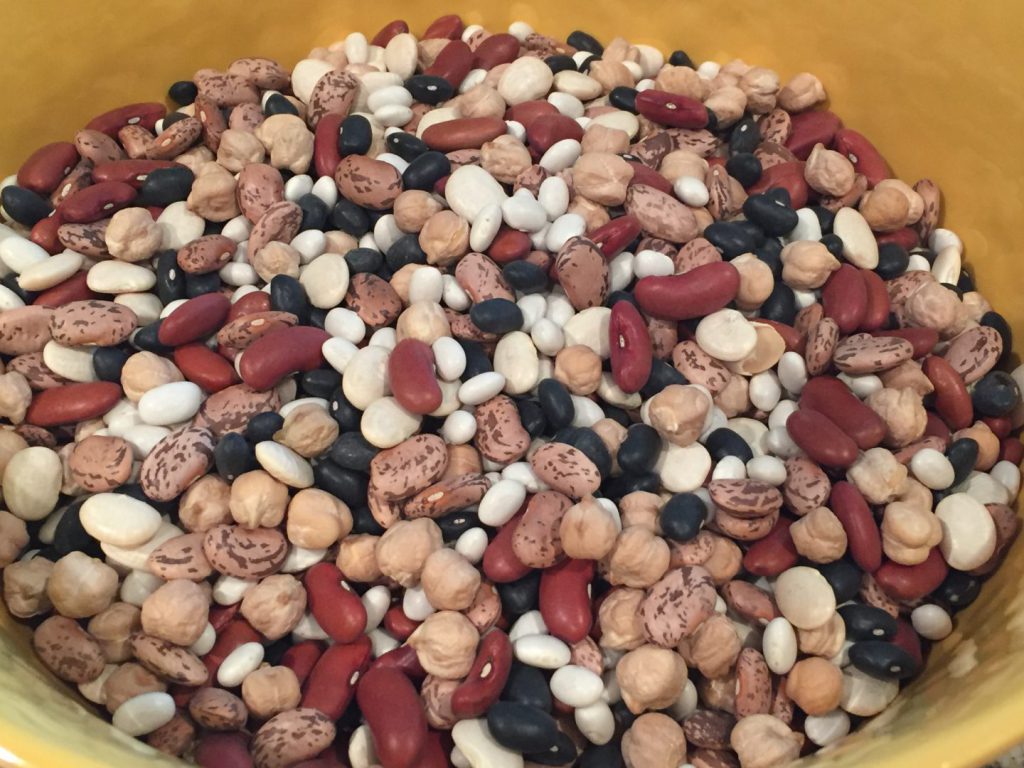
How to Store
All stored grains & beans require a cool moisture-free environment to avoid bugs and spoilage. Food grade plastic buckets or pails are the best option.
- Bucket/Pails Size – Bulk grains/beans can come in food-grade buckets/pails, heavy plastic or paper bags. If they come in a bag they cannot stay that way because bugs/critters and moisture can get to them. Store your bulk grains/beans in food grade plastic buckets with a lid that has a rubber gasket to seal out critters and moisture. A 5 gallon bucket will easily hold 25 lbs, where as a 6 gallon will almost hold 50 lbs.
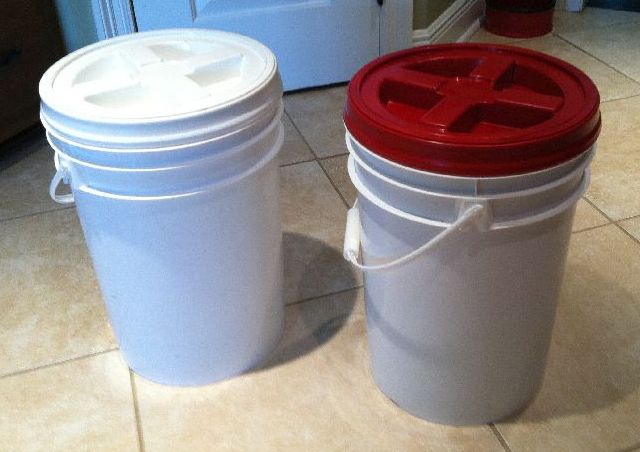
- Location – The best storage location is a pantry or an interior closet; you are looking for cool and dry. Buckets may be stored in the garage, however, be sure to set them on 2×4 boards to keep air circulating and prevent moisture from collecting on the buckets in humid environments/seasons. Do not store buckets in the laundry room; too warm and humid. Bugs love that!
- Bug & Moisture Control – Unfortunately, weevil eggs and such are typically already in grains from the fields; they hatch when the conditions are right: oxygen, warm & humid. For long-term storage it is recommended to use oxygen absorbers and Mylar bags. Oxygen absorbers do just that, removes the oxygen. By using the oxygen packs before sealing your buckets can help deter them from hatching. For a five gallon pail you will need approximately 2000cc strength of oxygen absorbers. To use: shake down the grain in the bucket, place oxygen pack(s) on top of the grain, then seal with standard long-term lid having a rubber gasket (not a Gamma lid). A Mylar bag used to line the inside of food grade bucket/pail helps add an extra layer of protection. Made of 3.5 to 5 mil heavy stretched polyester film, a great barrier of environments: air, moisture, light, bugs, etc.. Another option is to place your new grains in the freezer for a couple of days or more. This method will kill any bugs/eggs in the grain/beans. Remove, thaw completely, then store in food grade bucket with rubber gasket lid. For everyday grain usage, a food-grade bucket/pail and a Gamma lid. For daily convenience smaller quantities may be stored in a well sealed container on the counter, working from your bulk container pail. (see below). Note about my picture with the absorbers: My picture below shows oxygen absorbers in my half-empty wheat bucket using a Gamma lid. I only use the absorbers when I’m storing grain for a long time using a regular lid with a rubber gasket (see section on lids). Because once a bucket with oxygen absorbers has been opened the absorbers will no longer be effective. I just wanted you to see what they looked like.
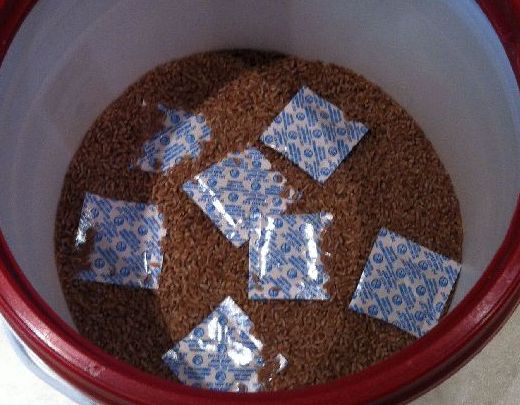
Bucket/Pail Lids
- Short Term Lids – Use a Gamma Lid for easy daily access of your bucketed grains & beans. Gamma Lids consist of a ring and screw-type lid each with a rubber gasket. Simply snap the ring onto your bucket (you may need to use a rubber mallet to seat the ring all the way) and screw on the lid to seal. When you’ve emptied your bucket, open the next sealed bucket and pour it into the Gamma lidded bucket. Gamma Lids are available in many colors. My Hard White wheat has a white lid and my Hard Red wheat has a red lid. I’ m O.C.D. like that.
- Long Term Lids – Long-Term lids are the typical 5-6 gallon bucket lids; like on a big bucket of paint. It has a deep seating groove and a rubber gasket. You may need a rubber mallet to seal the lid on properly. A lid-lifter is very helpful to remove these sealed lids. When using the oxygen absorbers often the lid will sink inward or dip down. That is normal and good; it simply means the absorbers are doing their job.
- Be sure to label your bucket with grain/bean type, date, purchased from info so you can rotate your stock. I use masking tape and a Sharpie.
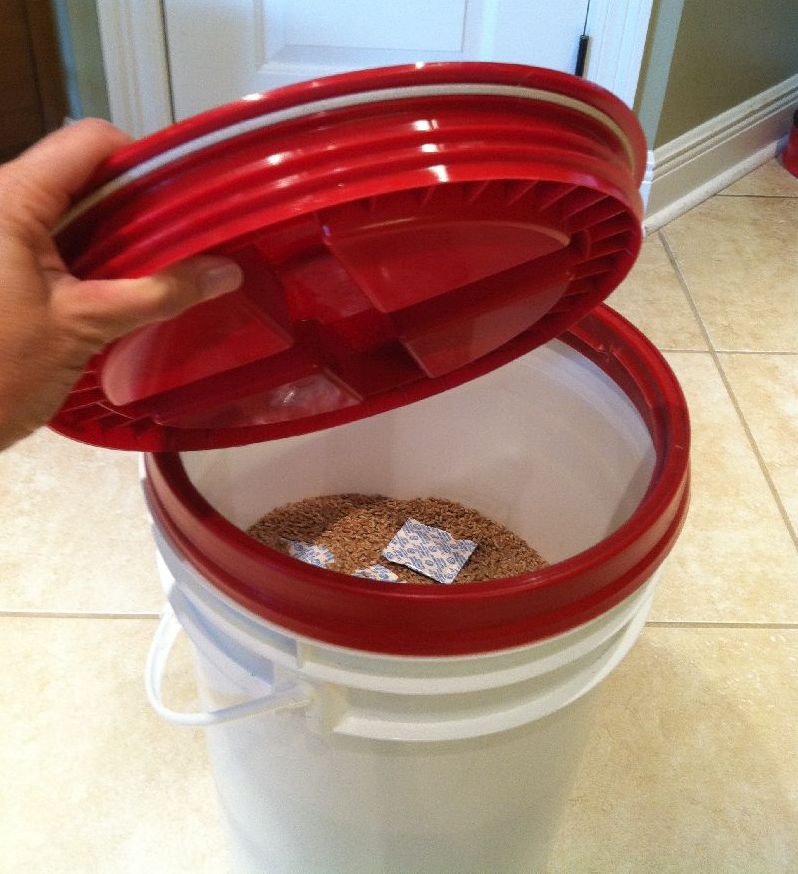
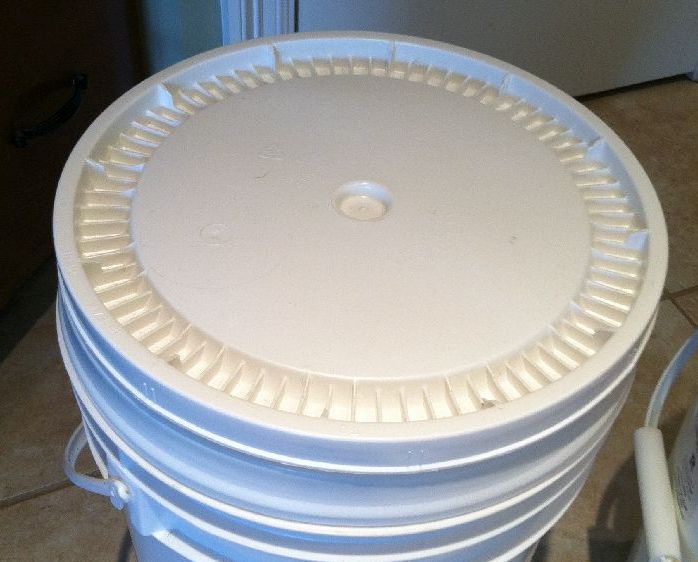
Where to Buy Storage Items
Food-grade buckets/pails and lids are available in different sizes like 2-gallon up to 7-gallon. Buckets/pails, regular lids and Gamma lids can definitely be found on-line, however some health food and hardware stores carry them in-stock. Call the store first for availability and don’t forget to price compare.
Food-Grade Buckets/Pails
Food-grade buckets/pails will have a number stamp of 2, 4, or 5 on the bottom in the triangle.
Pails marked “2” are made of high-density polyethylene (HDPE), the best choice for long-term storage.
- 5-Gallon hold a 25 lbs of grain/beans and are the easiest to find. Often they are carried by food co-ops such as Azure Standard. Lowe’s and Home Depot usually carry them in the paint section. Make sure you get FOOD-Grade; so, check it’s label. Both stores carry the regular lid and the Gamma-type lid; so, check with your particular store.
- 6-Gallon can hold 50lbs of grain/beans are a little trickier to find. Our local health food store carries them, but typically they will need to be ordered on-line. Simply Google “6 gallon food grade bucket or pail” and price compare. Because buckets are bulky, shipping cost can be a factor.
- Other sizes – Azure Standard carries 2-gallon & 5-gallon or may be found on-line.
Lids
- Regular lids are fairly easy to find. Make sure it has a rubber gasket for an air/moisture tight seal. Again, check with Azure Standard or your Lowe’s or Home Depot store. These lids typically come in white.
- Gamma lids may also be found at Azure Standard or Lowe’s or Home Depot. You will need to check with them as far as color goes; if you care about that sort of thing.
Note about colors – Gamma lids come in many colors: white, red, green, yellow, black and several others. Because I’m a little O.C.D. I have a white lid for my hard white wheat, a red lid for my hard red lid and yellow for my soft wheat; labeled white lids for all my other grains, corn and beans. You will have to do the Google search if color preference is your preference.
Oxygen Absorbers & Mylar Bags
- Oxygen Absorbers are available in different strengths i.e. 100cc, 300cc, 2000cc, etc. For five gallon pail choose close to a 2000 cc’s worth; either combine several lower strengths or one full strength for best results. May be found at Azure Standard or Amazon.
- Mylar Bags may also be found at Azure Standard and Amazon.
I hope you find this info helpful. Of course there is always more to say, but this will get you going in the right direction. Do read the following post/pages for even more information.
Additional helpful posts/pages:
- Read: Real Bread
- Read: History of White Flour
- Read: Getting Started Milling
- Read: Bread Making Tips
- Read: Ingredients
Other information:
Food Storage – Dried Beans
